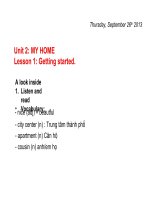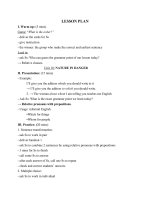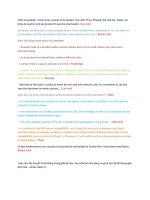UNIT 10 THI DIEM 11
Bạn đang xem bản rút gọn của tài liệu. Xem và tải ngay bản đầy đủ của tài liệu tại đây (229.07 KB, 45 trang )
Date: ..../ ..../ ......
Week: .......
Period : .......
UNIT 10: HEALTHY LIFESTYLE AND LONGEVITY
LESSON 1: GETTING STARTED
I. Objectives: After the lesson the students will be able to:
* use words and phrases related to healthy lifestyle and longevity
* recognise and use fall-rise intonation on statements and questions expressing invitations,
suggestions, polite requests, uncertainty and surprise
II. Contents:
III. Teaching aids: Textbooks, chalk, board …
IV. Anticipated problem and solution:
V. Time required: 45 minutes
VI. Procedures:
Stages
Teacher’s activities
Warm-up (5’)
Getting
How to stay healthy
started (39’)
Students’ activities
Lead-in: Inform the class of the lesson
objectives: getting to know the topic, some
vocabulary
related
to
lifestyle
and
longevity, and the two grammar points:
conditional sentences and to-infinitives /
gerunds in reported speech.
1. Tell Ss that they are going to listen to a
conversation between Kim and Max.
* Ask Ss to look at the visual diagram
illustrating the four principles of staying
healthy. Explain that each image represents
a principle.
* Play the recording. Have Ss listen and
read the conversation silently, and then
write the name of the correct principle
under each picture.
* Check Ss' answers as a class.
Hinh ve
2. This activity focuses on
collocations related to health
and lifestyles.
* Ask
Ss
to
read
the
conversation again and find
the verbs that go with the
nouns or noun phrases.
* Have Ss use a dictionary to
check the meaning of these
words and phrases.
Key: 1. relieve
2. weaken
practise
4. increase 5. do
practise
7. take
3. This activity focuses on
comprehension
of
the
read
the
conversation.
*
Have
Ss
incomplete notes and find
the
words
in
the
conversation to fill the gaps.
Remind them to use the
correct word forms.
Key:
1. relieving stress
2. we practise meditation
3. eating healthy food
4. developing heart disease
5. exercising regularly
6. sports; yoga and t'ai chi
7. natural remedies; take prescription
medicine
4. Ask Ss to work in pairs.
* Have Ss recall Dr Quan's four principles
and discuss the questions.
* Invite some pairs to report their
discussions to the rest of the class.
5.
Have
Ss
work
individually. Ask them to
reread the conversation and
pick out all the examples of
reported speech.
* Have Ss underline the
reporting verbs and the verb
forms
that
follow
the
reporting verbs.
* Draw Ss' attention to the
last two examples (sentences
4 and 5). Briefly explain that
an
infinitive or -ing form can be
used after a reporting verb in
reported speech.
Key:
1. Dr Quan said if you practised
meditation everyday, you could keep
your mind stress-free.
2. Yesterday, I read an article on the
Internet,
which
claimed
you
could
increase your life expectancy if you ate
brown rice, fruit and vegetables.
3. He said red meat is high in fat, which
increases the risk of developing heart
disease.
4. Dr Quan advised viewers to exercise
regularly.
5. He suggested playing sports when
you're young, or practising yoga and t'ai
chi...
Homework
(1’)
Date: ..../ ..../ ......
Week: .......
Period : .......
UNIT 10: HEALTHY LIFESTYLE AND LONGEVITY
LESSON 2: LANGUAGE
I. Objectives: After the lesson the students will be able to:
* use words and phrases related to healthy lifestyle and longevity
* recognise and use fall-rise intonation on statements and questions expressing invitations,
suggestions, polite requests, uncertainty and surprise
* use reported speech in different structures (to-infinitives, gerunds, and conditionals)
II. Contents:
III. Teaching aids: Handouts, Board, Chalk, Textbooks, CD …
IV. Anticipated problem and solution:
- Problem:
V. Time required: 45 minutes
VI. Procedures:
Stages
Warm-up
Vocabulary
Teacher’s activities
Students’ activities
1. Go through the words and
phrases in the box and check
Ss' understanding.
* Ask Ss to pay attention to
the contextual clues in the
incomplete
example,
sentences.
the
For
words
surrounding the gap can help
Ss to work out the part of
speech and the form of the
words to be used in the gap.
* Have Ss complete the
sentences individually.
In weaker classes, ask Ss to
work in pairs. Check answers
as a class.
Key: 1. cholesterol
3. natural remedies4.
immune
system
5. ageing process 6. meditation
7. Life expectancy 8. boost
2. Introduce some familiar
words formed with free and
anti-,e.g. duty-free (shop) and
antivirus (softy/are).
* Encourage Ss to-work out
the meaning of these words
and the meaning of free and
anti-.
Notes:
- duty-free shop: a shop at an airport where
you can buy goods without paying tax on
them (e.g. perfume, handbags, clothes,
etc.)
- antivirus software: software designed to
find and destroy computer viruses.
* Explain to Ss that free is
used
to
form
compound
adjectives, which are usually
hyphenated. On other hand,
anti- is used as a prefix to
form adjectives or nouns,
which can be spelled with
without a hyphen, e.g. antiaircraft
(adj),
anti-
alcoholism (n), anticlockwise
(adj), antidepressant (n, adj).
Key:
free:
without,
not
containing;
against, preventing, opposite
2. lifestyle that does not cause stress
3. foods that do not contain cholesterol
4. foods that are believed to prevent the
appearance from getting older
5. diet that prevents the formation of acne
6. medicine that lowers cholesterol levels
Pronunciation
or prevents high cholesterol
Intonation:
Invitations,
suggestions, polite requests,
uncertainty and surprise
Activities 1 and 2 focus on
fall-rise intonation.
1. Ask Ss to listen and repeat
the statements with fall-rise
intonation.
* Ask Ss to read the Do you
know...? box in pairs and
discuss the general rules for
fall-rise intonation. Check Ss'
understanding of the points
and have them read the
examples with appropriate
intonation.
*
Have
Ss
identify
the
function of each utterance.
Suggested answers
1. invitation / suggestion surprise
2. surprise
3. uncertainty
4. polite request
5. hesitation
Audio script
1. Another drink? ↑
2. You’re thirty years old? ↑ You look a lot
younger.
3. I'm not sure. ↑
4. Could you explain that again, please? ↑
5. Now, let me think... ↑
2. Ask Ss to
read the
exchanges and decide which
statements or questions may
be
spoken
with
fall-rise
intonation. Have Ss mark
them with the symbol (↑).
* Play the recording for Ss to
check their answers.
*
Let
Ss
practise
the
exchanges in pairs.
Audio script
1. A: Will you do me a favour? ↑
B: Sure. What can I do for you? ↑
2. A: I think acupuncture can reduce your
pain. ↑
B: Really?
3. A: Would you like another cup of tea? ↑
B: No, thanks. I've had enough.
4. A: What do you think about natural
remedies?
B: Um... They might be effective... ↑
5. A: Fast food is not good for your health.
Try not to eat too much of it.
B: OK, ill try. ↑
6. A: Mr Brown, did you hear the news?
What do you think about the project to
build a new airport in our neighbourhood?
B: Well, let me collect my thoughts... ↑
Note:
The pitch change (i.e. where the voice goes
down and then up) may occur on one word
or more words.
Examples:
- She is nice. ↑ (The pitch change can
occur on one word ‘nice’)
- Would you like another ↓ cup of tea
(The voice can go down on ‘another’ and
Grammar
then start going up on ‘tea’.)
Conditionals in reported
speech
1. Ask Ss to look at the Do
you know... ? box and study
the general rules for verb
form changes in reported
speech after a reporting verb
in the past tense.
* Remind them of changes to
pronouns (I - he / she
determiners
(this/these
-
that/those), and expressions
of place (here - there). Point
out that the expressions of
time are unchanged if the
information is still true.
Example: ‘If my flight to Hue
is cancelled tomorrow, I’ll
travel by train.’
=> My father said that if his
flight to Hue is cancelled
tomorrow, hell travel by
train. (Unchanged - reported
ten minutes later)
=> My father said that if his
flight to Hue was cancelled
the following day; he'd travel
by train. (Changed to type 2 reported two days later)
* Have Ss read the statements
and discuss in pairs, and then
decide if it is necessary to
change the verb tenses in
reported speech after past
reporting verbs.
Key: 1. C/U
2. C/U
5. U 6. U 7. U 8. C/U
2. Ask Ss to report the
statements in 1, using the
reporting
verbs
in
the
prompts.
* Have them compare their
answers in pairs. Check as a
class.
Key:
1. I told him (that) if I drank coffee before
bedtime, I couldn't sleep. (C)
I told him (that) if I drink coffee before
bedtime, 1 can't sleep. (U)
2. Dr Quan said (that) we'd boost our
immune system if we had a healthy
lifestyle. (C)
Dr Quan said (that) well boost our
immune system if we have a healthy
lifestyle. (U)
3. John's wife told him (that) it would be
nice if he could spend more time with the
children. (U)
4. Peter explained to us (that) if Ann called
him back, he'd arrange an appointment for
her. (U)
5. The travel agent explained to us (that) if
we travel to a foreign country, we need a
valid passport. (U)
6. My grandmother keeps telling us (that)
if we catch a cold, we should try natural
remedies before taking any medicine. (U)
7. John told me (that) if he were rich, he'd I
donate money to charity. (U)
8. Mary's father said (that) Mary / she
would recover quickly if she followed the
doctor's advice. (C)
Mary's father said (that) Mary / she will
recover quickly if she follows the doctor's
advice. (U)
Reported speech with to infinitives and gerunds
3. Explain that to-infinitives
or gerunds can be used to
report actions (e.g. promises,
orders, advice, etc.). Have Ss
read the Do you know...?)
box and focus on the verb
forms in reported speech
after the three groups of
reporting verbs.
Notes:
* A clause with that can be used after some
reporting verbs (admit, advise, agree,
insist promise, remind, suggest warn
Example: Jane promised that she wouldn't
be late again.
* Suggest + -ing form is used to report
what the subject should be doing himself
or what someone else should be doing.
* Have Ss write the sentences
in reported speech using the
reporting verbs in brackets.
Ask
them
to
compare
answers in pairs. Then check
as a class.
Key:
1. Jack's father advised him not to eat fast
food every day.
2. Ann asked Kim to do the dishes for her.
3. The doctor told me to do a 30-minute
workout every day.
4. Mai invited Peter to go out for a coffee.
5. Phong apologised for breaking my
glasses.
6. Hoa reminded Lan to buy some
groceries I on the way home.
7. Carol suggested enrolling on a yoga
course.
8. John and Max admitted forgetting to I
submit the assignments the day before.
4. Ask Ss to change the
sentences in reported speech
into direct speech.
* In weaker classes, ask Ss to
work in pairs or groups, if
necessary,
helpful
provide
verbs,
expressions
remember,
some
modals
or
such
as
should,
would,
let's, etc. for Ss to use.
* Check answers as a class.
Invite
Ss
to
read
each
sentence and point out the
changes they have made.
Key:
2.‘Kim, don't forget to turn off the lights
before leaving the house.’ (or: ‘Kim,
remember to turn off...’)
3. ‘You shouldn't exercise too hard because
it's not good for your heart.’
4. ‘Let's have a picnic next weekend.’ (or:
‘Why: don't we have a picnic next
weekend?)
5. ‘Don’t play near the construction site.’
6. ‘Would you like to spend your summer
holidays on my grandparents' farm?’
7. I'm sorry, I've made lots of mistakes in
the report.’ (or: I'm sorry for making lots of
mistakes in the report.’)
8. ‘Yes. I took my father's car without
permission.’
LESSON
* Ask Ss: What have you learnt today?
OUTCOME
What can you do now?
* Elicit answers: I have learnt how to use
fail-rise
intonation
questions
on
expressing
statements
and
Invitations,
suggestions, polite requests, uncertainty and
surprise, I can report
speech
using
different
structures
(to-
infinitives, gerunds, and conditionals).
Homeork
Date: ..../ ..../ ......
Week: .......
Period : .......
UNIT 10: HEALTHY LIFESTYLE AND LONGEVITY
LESSON 3: READING
I. Objectives: After the lesson the students will be able to:
* use words and phrases related to healthy lifestyle and longevity
* read for specific information in a text about factors responsible for the increase In life
expectancy
II. Contents:
III. Teaching aids: Textbooks, chalk, board …
IV. Anticipated problem and solution:
V. Time required: 45 minutes
VI. Procedures:
Stages
Warm-up
(5’)
Pre-reading (5’)
Teacher’s activities
Students’ activities
Life expectancy factors
Lead-in: Inform the class of
the lesson objectives: sloping
the ability to follow the
logical structure text and
reading
for
specific
information.
1. Ask Ss to look at the
pictures of machines that help
doctors to diagnose or treat
diseases.
* Have Ss work in pairs and
answer the questions.
* Invite some pairs to report
their discussions to the lass.
Further explain the use of the
machines.
Suggested answer
a. & b, MRI (Magnetic Resonance Imaging)
scanners and X-ray machines take medical
images of patients’ internal body parts.
MRI images provide a 30 representation of
While-reading (20’)
organs, which X-rays usually cannot.
2. Tell Ss that they are going
to read a text about life
expectancy factors, which has
four sentences removed from
it.
* Ask Ss to read through the
sentences (a-d) and underline
key words or words used for
reference
determiners,
pronouns, etc). This can help
them to choose the correct
sentence for each gap in the
text.
Examples:
a. The last century's advances
b. regular exercise, additional
life expectancy
c. This increase, three main
factors
d. Eating more fruits and
vegetables
*
Have
Ss
read
each
paragraph of the text and look
for information before and
after each lap that has some
connection to the key or
reference words they have
underlined in the sentences
(a-d).
* Ask Ss to compare answers
in pairs, reading the entire
text to ensure that each
sentence fits well and the
information is coherent.
* Check answers as a class.
Key:
1. c (This increase - 67.2 years... 82.6 years;
three main factors - introduces the main
ideas of the whole text that are developed in
I the following paragraphs)
2. b (regular exercise - physical activity
3. d (Eating more fruits and vegetables food we eat, simple dietary changes
4. a (The last century's advances technology medical developments
3. This activity focuses on
vocabulary recognition and
building.
* Have Ss read through the
definitions
and
the
text
carefully, looking for the
correct words or phrases that
match with the definitions.
* Check answers as a class.
Key: 1. be attributed (to)
3. antibiotics
4. vaccine
5. dietary
4. Ask Ss to read the full text,
including
the
gapped
sentences, again and answer
the questions individually.
* Have Ss compare their
answers in pairs. Check as a
class.
Key:
1. The three factors are healthier lifestyles,
better nutrition and advances in medical
science and technology.
2. Smoking, alcohol intake and fast food
consumption can increase the risk of heart
disease.
3. Doing regular physical activity and
spending more time outdoors can improve
the ability of the human body to function
well.
4. Because they want to relieve stress.
5. Because the food we eat can affect
longevity and dietary changes can boost our
immune system.
6. They are the discovery of antibiotics and
vaccines, and the development of medical
imaging.
Post-reading 5. Have Ss discuss with a partner. Ask them to
(10’)
summarise the three factors that affect
people’s life expectancy before they start their
discussion:
- Healthy lifestyles (physical exercise, low
levels of stress and anxiety)
- Better nutrition (nutritious diets and dietary
changes)
- Advances in medico science and technology
* Ask them to decide which factor they think
is the lost important for prolonging life
expectancy. Encourage them to provide their
arguments or reasons.
Lesson
Outcome (4’)
* Ask Ss: What have you learnt today?
What can you do now?
* Elicit answers: I have learnt about factors
that affect people's life expectancy. I can work
out the logical structure of a text by analysing
words used for reference. I can read for
specific information and key words.
Homework
(1’)
Date: ..../ ..../ ......
Week: .......
Period : .......
UNIT 10: HEALTHY LIFESTYLE AND LONGEVITY
LESSON 4: SPEAKING
I. Objectives: After the lesson the students will be able to:
* use words and phrases related to healthy lifestyle and longevity
* give advice on body care
II. Contents:
III. Teaching aids: Textbooks, chalk, board …
IV. Anticipated problem and solution:
V. Time required: 45 minutes
VI. Procedures:
Stages
Warm-up
(5’)
Pre-speaking (10’)
Teacher’s activities
Students’ activities
Lead-in: Inform the class of
the
lesson
objectives
improving presentation skills
by giving a talk on skincare.
1. Ask Ss to look at the set of
note cards for a talk on
skincare.
* Explain to Ss that note
cards can be a very helpful
tool for preparing, rehearsing
and delivering speeches or
talks. The note cards should
contain p most important
information as bullet points,
which can be used as prompts
in
case
the
speaker
its
nervous or forgets what to
say.
* Give some guidelines on
how to prepare note cards:
a. Prepare small-sized cards
(approximately 6x10cm).
b. Have one idea or one main
heading per card.
c.
Use
bullet
points
or
numbers to list supporting
ideas
under
the
main
heading; the exception is the
first and last cards (i.e. for
introduction and conclusion)
on which you can write
complete sentences to help
you to have a good, smooth
start and ending.
d. Write on one side of the
card.
e. Number the cards so that
you know the order they
come in.
* Have Ss work in pairs and
read
through
the
six
supporting ideas in the box
and the sample note cards.
Ask them to discuss which
ideas should be used for each
of the tips on the cards
(numbered 2, 3 and 4).
* Have pairs make their own
note cards and present their
answers to the class.
Key:
B1:
- wear protective clothing => avoid
sunburn
- wear sunscreen with a sun protection
factor (SPF) of at least 15
B2:
- eat a wide variety of fruit and
vegetables
=>
provide
vitamins
and
nutrients
- drink a lot of water => prevent water
loss
B3:
- wash your face twice a day with
warm water and mild soap => remove dirt
- don't squeeze pimples => can lead to
swelling, redness and infection
Whilespeaking
(18’)
2. Ask Ss to read through the guidelines on
how to give a talk successfully.
* Give further explanations on when to use
some common linking words / expressions and
hesitation devices.
a.
to
introduce
ideas
in
sequence
(First/Second/Next/Last)
b.
to
add
further
ideas
(Moreover/
Furthermore / In addition / What's more)
c. to clarify an idea (What I mean is... /In
Other words/I mean / To put it another way)
d. to stall for time (Let me think/Now let me
collect my thoughts)
* Have Ss practise the talk on skincare in
pairs. Remind them to use the note cards and
the guidelines.
* Invite one or two students to give the talk in
front of the class.
3. Activities 3 and 4 provide further practice in
giving a talk on another health-related topic.
* Have Ss work individually. Ask them to read
the suggested ideas for taking care of their
vision and prepare a set of note cards for their
talk.
Post-
4. Ask Ss to work in groups of four or five and
speaking
take turns presenting their talk to the group
(8’)
members.
* Invite some Ss to give their talk in front of
the class.
Lessons
Outcome
(3’)
* Ask Ss:
What have you learnt today?
What can you do now?
* Elicit answers: I have learnt how to prepare
note cards for a talk. I can give a talk
naturally and smoothly in front of an
audience. I can give advice on body care.
Homework
(1’)
Date: ..../ ..../ ......
Week: .......
Period : .......
UNIT 10: HEALTHY LIFESTYLE AND LONGEVITY
LESSON 5: LISTENING
I. Objectives: After the lesson the students will be able to:
* use words and phrases related to healthy lifestyle and longevity
* listen for specific information In a talk about physical activity precautions
II. Contents:
III. Teaching aids: Textbooks, chalk, board …
IV. Anticipated problem and solution:
V. Time required: 45 minutes
VI. Procedures:
Stages
Teacher’s activities
Warm-up
(5)
Pre-listening Exercise precautions
Lead-in: Inform the class of the lesson
objectives: listening for specific information in
a talk on precautions when doing four types of
physical activity.
1. Ask Ss some guiding questions: Name some
types of physical exercise that most people in
your eighbourhood often do. Where do they
practise lese activities?
* Have Ss work in pairs and discuss the two
questions.
* Ask some Ss to summarise their discussion
Students’ activities









